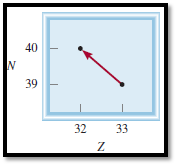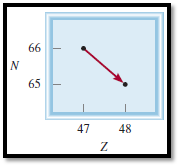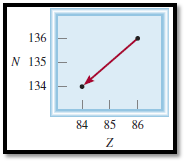
(a)
Interpretation:
The type of decay and the isotope which undergoes that particular decay should be identified.
Concept Introduction:
Nuclear reaction is a physical process in which there is a change in identity of an atomic nucleus. Natural radioactive decays, artificial radioactive decays... are considered as nuclear reactions because these processes make changes in the identity of an atomic nucleus.
Common particles in radioactive decay and nuclear transformations are mentioned below,
There are various types of nuclear processes. The changes in
An isotope can be represented using
(a)
Explanation of Solution
Given diagram for the decay is,

Figure 1
From the diagram the isotope can be identified,
Atomic number is decreased from
The nuclear reaction can be represented as,
(b)
Interpretation:
The type of decay and the isotope which undergoes that particular decay should be identified.
Concept Introduction:
Nuclear reaction is a physical process in which there is a change in identity of an atomic nucleus. Natural radioactive decays, artificial radioactive decays... are considered as nuclear reactions because these processes make changes in the identity of an atomic nucleus.
Common particles in radioactive decay and nuclear transformations are mentioned below,
There are various types of nuclear processes. The changes in atomic number and mass number accompanying radioactive decay are mentioned below,
(b)
Explanation of Solution
Given diagram for the decay is,

Figure 2
From the diagram the isotope can be identified,
Atomic number is increased from
The nuclear reaction can be represented as,
(c)
Interpretation:
The type of decay and the isotope which undergoes that particular decay should be identified.
Concept Introduction:
Nuclear reaction is a physical process in which there is a change in identity of an atomic nucleus. Natural radioactive decays, artificial radioactive decays... are considered as nuclear reactions because these processes make changes in the identity of an atomic nucleus.
Common particles in radioactive decay and nuclear transformations are mentioned below,
There are various types of nuclear processes. The changes in atomic number and mass number accompanying radioactive decay are mentioned below,
(c)
Explanation of Solution
Given diagram for the decay is,

Figure 3
From the diagram the isotope can be identified.
Atomic number is decreased from
The nuclear reaction can be represented as,
Want to see more full solutions like this?
Chapter 21 Solutions
EBK GENERAL CHEMISTRY: THE ESSENTIAL CO
- Identify the compound with the longest carbon - nitrogen bond. O CH3CH2CH=NH O CH3CH2NH2 CH3CH2C=N CH3CH=NCH 3 The length of all the carbon-nitrogen bonds are the samearrow_forwardIdentify any polar covalent bonds in epichlorohydrin with S+ and 8- symbols in the appropriate locations. Choose the correct answer below. Η H's+ 6Η Η Η Η Η Ηδ Η Ο Ο HH +Η Η +Η Η Η -8+ CIarrow_forwardH H:O::::H H H HH H::O:D:D:H HH HH H:O:D:D:H .. HH H:O:D:D:H H H Select the correct Lewis dot structure for the following compound: CH3CH2OHarrow_forward
- Rank the following compounds in order of decreasing boiling point. ннннн -С-С-Н . н-с- ННННН H ΗΤΗ НННН TTTĪ н-с-с-с-с-о-н НННН НН C' Н н-с-с-с-с-н НН || Ш НННН H-C-C-C-C-N-H ННННН IVarrow_forwardRank the following compounds in order of decreasing dipole moment. |>||>||| ||>|||>| |>|||>|| |||>||>| O ||>>||| H F H F H c=c || H c=c F F IIIarrow_forwardchoose the description that best describes the geometry for the following charged species ch3-arrow_forward
- Why isn't the ketone in this compound converted to an acetal or hemiacetal by the alcohol and acid?arrow_forwardWhat is the approximate bond angle around the nitrogen atom? HNH H Harrow_forwardOH 1. NaOCH2CH3 Q 2. CH3CH2Br (1 equiv) H3O+ Select to Draw 1. NaOCH2 CH3 2. CH3Br (1 equiv) heat Select to Edit Select to Drawarrow_forward
- Complete and balance the following half-reaction in acidic solution. Be sure to include the proper phases for all species within the reaction. S₂O₃²⁻(aq) → S₄O₆²⁻(aq)arrow_forwardQ Select to Edit NH3 (CH3)2CHCI (1 equiv) AICI 3 Select to Draw cat. H2SO4 SO3 (1 equiv) HO SOCl2 pyridine Select to Edit >arrow_forwardComplete and balance the following half-reaction in basic solution. Be sure to include the proper phases for all species within the reaction. Zn(s) → Zn(OH)₄²⁻(aq)arrow_forward
 ChemistryChemistryISBN:9781305957404Author:Steven S. Zumdahl, Susan A. Zumdahl, Donald J. DeCostePublisher:Cengage Learning
ChemistryChemistryISBN:9781305957404Author:Steven S. Zumdahl, Susan A. Zumdahl, Donald J. DeCostePublisher:Cengage Learning ChemistryChemistryISBN:9781259911156Author:Raymond Chang Dr., Jason Overby ProfessorPublisher:McGraw-Hill Education
ChemistryChemistryISBN:9781259911156Author:Raymond Chang Dr., Jason Overby ProfessorPublisher:McGraw-Hill Education Principles of Instrumental AnalysisChemistryISBN:9781305577213Author:Douglas A. Skoog, F. James Holler, Stanley R. CrouchPublisher:Cengage Learning
Principles of Instrumental AnalysisChemistryISBN:9781305577213Author:Douglas A. Skoog, F. James Holler, Stanley R. CrouchPublisher:Cengage Learning Organic ChemistryChemistryISBN:9780078021558Author:Janice Gorzynski Smith Dr.Publisher:McGraw-Hill Education
Organic ChemistryChemistryISBN:9780078021558Author:Janice Gorzynski Smith Dr.Publisher:McGraw-Hill Education Chemistry: Principles and ReactionsChemistryISBN:9781305079373Author:William L. Masterton, Cecile N. HurleyPublisher:Cengage Learning
Chemistry: Principles and ReactionsChemistryISBN:9781305079373Author:William L. Masterton, Cecile N. HurleyPublisher:Cengage Learning Elementary Principles of Chemical Processes, Bind...ChemistryISBN:9781118431221Author:Richard M. Felder, Ronald W. Rousseau, Lisa G. BullardPublisher:WILEY
Elementary Principles of Chemical Processes, Bind...ChemistryISBN:9781118431221Author:Richard M. Felder, Ronald W. Rousseau, Lisa G. BullardPublisher:WILEY





